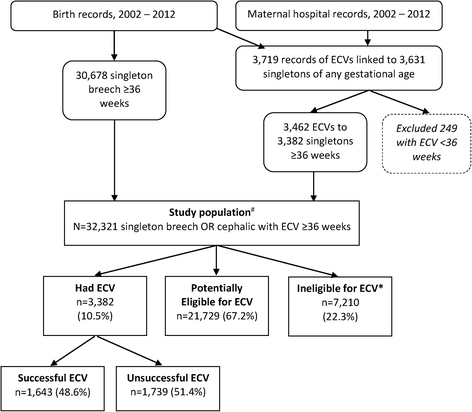Uptake of external cephalic version for term breech presentation: an Australian population study, 2002-2012
- PMID: 28747173
- PMCID: PMC5530508
- DOI: 10.1186/s12884-017-1430-5
Uptake of external cephalic version for term breech presentation: an Australian population study, 2002-2012
Abstract
Background: The safety, efficacy, and cost-effectiveness of external cephalic version (ECV) for term breech presentation has been demonstrated. Clinical guidelines recommend ECV for all eligible women, but the uptake of this procedure in the Australian healthcare setting is unknown. This study aimed to describe ECV uptake in New South Wales, the most populous state of Australia, during 2002 to 2012.
Methods: Data from routine hospital and birth records were used to identify ECVs conducted at ≥36 weeks' gestation. Women with ECV were compared to women who were potentially eligible for but did not have ECV. Eligibility for ECV was based on clinical guidelines. For those with ECV, birth outcomes following successful and unsuccessful procedures were examined.
Results: In N = 32,321 singleton breech pregnancies, 10.5% had ECV, 22.3% were ineligible, and 67.2% were potentially eligible but did not undergo ECV. Compared to women who were eligible but who did not attempt ECV, those who had ECV were more likely to be older, multiparous, overseas-born, public patients at delivery, and to deliver in tertiary hospitals in urban areas (p < 0.01). Fewer women who underwent ECV smoked during pregnancy, fewer were morbidly obese, and fewer had a hypertensive disorder of pregnancy, compared to those who were eligible. Caesarean section occurred in 25.9% of successful compared to 95.6% of unsuccessful ECVs. Infant outcomes did not differ by ECV success.
Conclusions: The majority of women with a breech presentation did not receive ECV. It is unclear whether this is attributable to issues with service provision or low acceptability among women. Policies to improve access to and information about ECV appear necessary to improve uptake among women with term breech presentation. Improved data collection around the diagnosis of breech presentation, ECV attempts, and outcomes may help to identify specific barriers to ECV uptake.
Keywords: Australia; Breech presentation; External cephalic version; Prenatal care; Retrospective studies; Term birth.
Conflict of interest statement
Consent for publication
Not applicable.
Competing interests
The authors declare that they have no competing interests.
Publisher’s Note
Springer Nature remains neutral with regard to jurisdictional claims in published maps and institutional affiliations.
Figures

References
-
- Royal Australian and New Zealand College of Obstetricians and Gynaecologists (RANZCOG). Management of Breech Presentation at Term. 2013.
MeSH terms
LinkOut - more resources
Full Text Sources
Other Literature Sources
Medical

